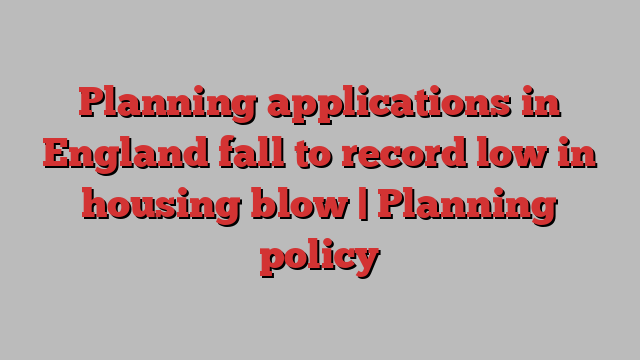
Planning applications in England have fallen to their lowest level in at least 16 years, according to figures published this week by the levelling up department that highlight the scale of the country’s housing crisis.
Local authorities received fewer applications to build new buildings or improve old ones in 2022 than at any point since before 2006, the earliest year for which the government provides statistics.
Rough sleeping in England is on the rise for the first time in five years, and experts say the lack of new planning applications means the housing shortfall will get worse over the coming years.
The figures add weight to a recent study by the Home Builders Federation, which predicted England’s housebuilding levels would soon fall to their lowest level since the second world war.
Paul Smith, the managing director of the Strategic Land Group, a consultancy, said: “The uncertainty around where the planning system is heading and what it will look like is a significant contributory factor in this fall. Local housing plans are not being made, and if plans are not being made then applications will not be submitted and developments will not get built.”
Matthew Pennycook, the shadow housing minister, said: “These statistics provide yet more evidence that Rishi Sunak and Michael Gove have set in train a collapse in housebuilding across England, with all the harmful social and economic consequences that will entail. Labour are now the only party serious about boosting the supply of new homes to buy and rent.”
The data, which was released without publicity on Thursday, shows that local authorities received 409,459 planning applications in 2022, down nearly 14% on the previous year.
The number of planning applications being submitted has been falling steadily since early 2021, and in the last three months of 2022 they fell to their lowest level since a brief crash at the start of the pandemic.
The proportion of applications being granted has fallen in line with the number that have been submitted. There were 11% fewer applications granted last year than in 2021, and experts say the number is likely to fall even further next year as a result of the drop in applications this year.
A spokesperson for the Department for Levelling Up, Housing and Communities said: “Last year planning permission was granted for more than 287,000 homes – showing councils have continued to progress decisions despite the challenges of the pandemic.”
Experts say developers in particular are being deterred by changes to the planning system brought in by successive Conservative governments. The Tories were elected in 2019 on a promise to set a mandatory target to build 300,000 new homes a year. That target meant local authorities were incentivised to set ambitious housing plans, which in turn gave housebuilders confidence that their projects would be approved.
after newsletter promotion
This was thrown into doubt, however, by the election of Liz Truss as Conservative leader and prime minister, who promised to ditch the target, calling it “Stalinist”.
After Truss’s departure from office, the levelling up secretary, Michael Gove, recommitted to the target but faced opposition from backbench Tory MPs and dropped it in early December, making it “advisory” instead.
He also changed the planning rules in other ways to make it easier for local authorities not to earmark sites for development, such as by dropping a requirement for them to show they have enough land for five years’ worth of new building.
The accumulated impact of the changes has been to bring development planning at local authorities nearly to a standstill. According to research by the Home Builders Federation, 30 local authorities reduced, delayed or stalled their housebuilding plans in the months leading up to Gove’s decision to drop the mandatory target, and another 25 have done so since.
The federation has estimated that England’s new housing supply could drop below 120,000 later this decade, the lowest level in more than 80 years.